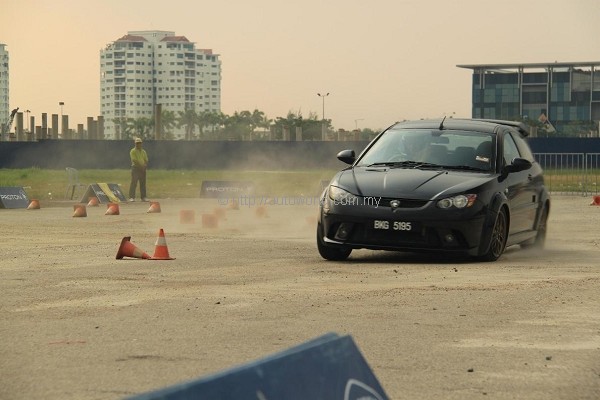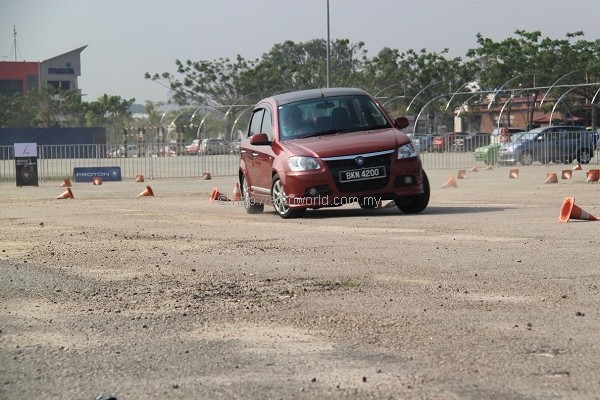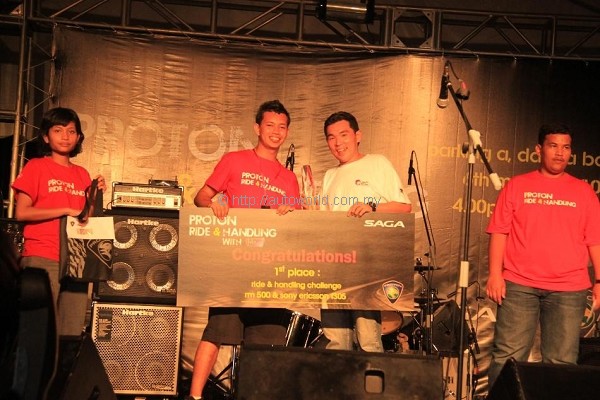Proton Ride & Handling – Johor Bahru
SUBANG JAYA, 17 March 2010 – Words cannot even begin to do justice to the world-acclaimed “Lotus ride and handling”, and it was precisely with this in mind that Proton Edar Sdn Bhd decided that the best way to allow people to experience this technology that has gone into designing today’s new generation of Proton cars was to simply allow people into the driver’s seat and behind the wheel.
In a fun-filled weekend of driving on Saturday, 6 March 2010, Proton Edar together with popular radio station Hitz.fm organized the PROTON Ride & Handling event at Danga Bay in Johor Bahru.
The event consisted of a number of activities, all evolving around enabling consumers to better understand the importance of ride and handling, and more importantly, how Lotus engineering wizardry influences the driving dynamics of today’s Proton car.
In an extreme test of agility and driving dynamics, a total of 50 participants signed up to compete in a ride and handling challenge behind the wheel of a Proton Saga SE and Satria Neo CPS. With the choice of driving a showroom model car fitted with an automatic or a five-speed manual transmission, contestants pitted their driving skills against one another around a safely-designed vehicle obstacle course in a race against time.
“The objective of the challenge was to enable contestants to experience what is precisely meant by Lotus ride and handling and as we had anticipated, most were absolutely surprised at the cars’ driving characteristics,” said Proton Edar Chief Executive Officer Mohamad Shukor bin Ibrahim.
“Many concluded their drive pleasantly surprised, and while many expected the Satria Neo to perform well, they never expected that even an introductory model like the Saga has the balance, agility, cornering dynamics, predictability and precise handling characteristics capable of rivaling many of today’s vehicles that are priced much higher.”
While it may be common knowledge that PROTON owns world-renowned British engineering firm Lotus, Mohamad Shukor said many still remained skeptical as to whether the latter’s technical inputs are actually incorporated into Proton cars.
“Ride and handling is unfortunately not an element that can be visually appreciated, and more often than not, underestimated and much misunderstood. As much as the challenge was about demonstrating the Saga and Satria Neo’s capabilities, it was also to correct misconceptions and inform car owners that excellent ride and handling does not need to come with an expensive price tag.
“While the level of refinements, engineering and electronics wizardry will obviously vary according to the pricing of any vehicle, the basic and fundamental importance of ride and handling remains consistent and one that evolves around the safety of a vehicle.”
Similarly, while there are differences between the Saga and Satria Neo – to suit the car’s individual characteristics and type of buyers and usage – both are designed and built with the common goal of providing drivers with greater control, safety and driving enjoyment.
Like the Saga and Satria Neo, Lotus ride and handling in the new generation of Proton cars are conveyed in the form of improved steering precision, cornering and handling capabilities via its suspension set-up, which translates into the vehicle being more agile, well-planted, stable, and allows the driver to register great precision in terms of lane changing behavior. Lotus ride and handling begins with structural and body rigidity of a vehicle which is the most important pre-requisite to a vehicle’s superior handling and agility.
Combined, this is what underlines the Active Safety components in a Proton car. Active safety is the technology designed to assist in the prevention of a crash.
While exceptional ride and handling doesn’t defy the laws of physics, it does provide drivers with a higher degree of vehicle safety in relation to control and the behavior of the vehicle especially when being driven hard.
The quality of ride meanwhile, is influenced by various factors such as high frequency vibrations, body roll and pitch. An uncomfortable ride is defined by the vehicle body rolling (leans to the side) excessively in turns, or lurches and pitches during acceleration and braking, or if the body produces a booming resonance.
Mohamad Shukor said with a series of similar events planned for the year, PROTON believes more and more car owners will not only begin to understand but appreciate and value the importance of superior ride and handling and how this translates to both safety of the vehicle and driving enjoyment.
“Beyond the selling of Proton cars, we hope to instill greater awareness (in ride and handling) in car buyers and why in the developed markets around the world today, the emphasis is very much on safety and not purely influenced by price.”
During the event, visitors were also offered to test drive the Satria Neo CPS, Saga SE and Gen.2 CPS models over a specially set-up course. PROTON also put up a mini technologies display that gave a more elaborate explanation of Lotus ride and handling in Proton cars, in addition to communicating the importance of functions such as the anti-lock brake system (ABS) and electronic brake distribution (EBD). Also on display was the CAMPRO engine. LOTUS meanwhile, showcased its range of vehicles and performed a driving demonstration.
Other activities included the showcase and contest of outstanding cars from the southern region chapters of the Gen.2 Club, PROSBOC (Proton Saga BLM Owners Club) and the Satria Neo Club.com, the sale of PROTON Lifestyle merchandise, games and quizzes by Hitz.fm’s radio announcers, and performances by local artistes Pesawat and One Buck Short.





























